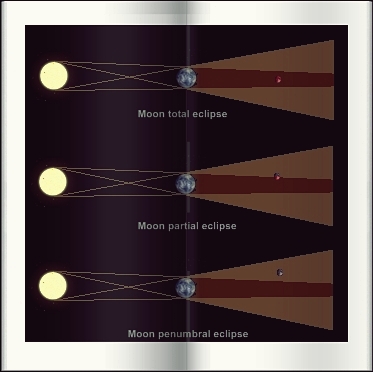
| CONTENT - All about the Moon eclipses, another major astronomical phenomenon |
Moon eclipses work according the same mechanism that the eclipses of the Sun. In the case of Moon eclipses, it's the Earth which is screening the Sun to the Moon. Like for the Sun eclipses, celestial mechanics do not provide us with a Moon eclipse at each lunar orbit. Moon eclipses are as rare as solar eclipses. Moon eclipses occur at full moon as, at the opposite of solar eclipses which occur for a part of the Earth only, Moon's eclipses are visible everywhere on Earth, provided to be on the right side, that is on Earth's night side

In the same way that the Sun, during Sun eclipses, is generating three different kinds of shadows through the Moon, it does so through the Earth. Trailing on the other side of the Earth are found an "umbra", an "antumbra", and a "penumbra" (from three Latin words meaning "shadow", opposed to the umbra", and "near umbra"). That is that, at an appropriate location, a theoretical observer would respectively see the Earth entirely masking the Sun there where the "umbra" is (he would see a total Sun eclipse), a ring of Sun surrounding the dark disk of the Earth at the "antumbra" (it would be an annular Sun eclipse), and a Sun partially occulted only in the "penumbra". Due to the configuration of the Earth-Moon system, the "umbra" and the "penumbra" only are involved in a Moon eclipse, as it would need the Moon to be located about 4 times farther from the Earth to see the Earth at a smaller apparent diameter than the Sun

The "umbra" and the "penumbra" determine which kind of Moon eclipse is occuring. If the Moon passes inside the Earth's umbra, it's a total Moon eclipse which occurs. If the Moon passes partly in the Earth's umbra only, it's a partial Moon eclipse occurring. Or when the Moon passes inside the penumbra only, it's a penumbral Moon eclipse. Out of accuracy, one will note that due to the atmospherical phenomenon of the 'refraction' (with the solar rays deviated from a straight line), the cone of Earth's umbra does not reach the near one-mile of length it can theoretically reach but a mere 166,500 miles. Thus, the Moon, strictly, is never affected by the umbra but better by a area located betwee umbra's tip and a portion of 62,000 or more miles of the penumbra
There may be up to 3 lunar eclipses each year (5 including penumbral), or none. There cannot be more than 7 eclipses in any one year, generally: 4 solar and 3 lunar, or 5 solar and 2 lunar (penumbral not included). A Moon eclipse usually precedes, or follows a Sun eclipse by about 2 weeks. In terms of eclipses, both solar and lunar, a 'Saros' is a period of 6,585.3 days (18 years 11 days 8 hours) by the end of which eclipses repeat. Albeit the eclipses' geometry is not exactly the same, they are close enough however to allow Saros to themselves settle into series which last 12 centuries or more. During one Saros, a average of 84 eclipses are found which part evenly between 42 solar, and 42 lunar ones. From the year 0 to 2999, 7,245 lunar eclipses are extant, of which 2,089 total, 2,536 partial, and 2,620 are penumbral. Two successive full moons can give rise to the lunar eclipse, but they would be partial eclipses only. Longest lunar eclipse on record was 236 minutes, July 16, 2000. When Moon is near apogee, it's moving more slowly across the sky, and if that occurs during an eclipse, that makes it a longer eclipse. There are maximum tides with a eclipse alignment. Some total lunar eclipses occur in a row of four, with no partial lunar eclipses in between and each one separated from the other by six full moons (some are calling the first such eclipse of the series a 'Blood Moon'). Such a series of four consecutive total lunar eclipses, on a other hand, is known as a 'tetrad.' 142 tetrads only concern a 5000-year period from 1999 B.C. to 3000 A.D. During the present millennium, the first eclipse of every tetrad occurs sometime from February to July. The mechanism causing tetrads involves the eccentricity of Earth's orbit which, further, is slowly decreasing. When Earth's eccentricity will be 0 in a distant future, tetrads will be no longer possible. Umbral magnitudes of total eclipses making up a tetrad are all relatively small
Website Manager: G. Guichard, site 'Amateur Astronomy,' http://stars5.6te.net. Page Editor: G. Guichard. last edited: 12/19/2014. contact us at ggwebsites@outlook.com